|
American Federal Projects 1975 - 1985
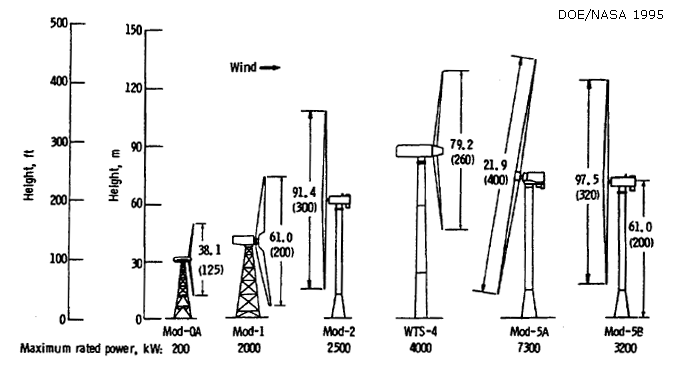
A major program of research and development projects was conducted at the NASA Lewis Research Center from 1973 to 1988, mostly sponsored by the US DOE. In 1979 - 80 almost 100 engineers and technicians were involved.
|
Like in some European countries, the United States Federal spendings on Wind Power research were mostly given to major industrial firms like Westinghouse, Boeing, Locheed and General Electric. The results from these projects were poor, and none of these companies followed the early results with a commercial Turbine production. A few Turbines though, had a technical standard that was close to what we consider sound and safe now. But no one dared to invest in those big Turbines back then. The commercial infrastructure was absent. The new Wind Power Industry instead emerged from companies, that produced small Turbines and grew them bigger as they gained commercial and practical experience. |
The order, in which Turbines are listed below, does not necessarily indicate a chronological order.
|
Project |
Period |
NASA/DOE MOD-0 |
|
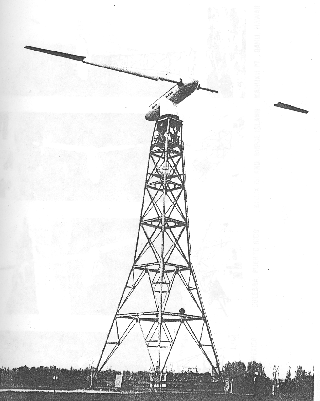 |
| Configuration: |
Downwind |
|
| Rotor Dia. [m] |
38.1 |
|
| Rotor r.p.m. |
40 |
|
| Power [kW] |
100kW |
|
| Power Regulation |
Pitch |
|
| Blade Number |
2 |
|
| Blade Material |
Aluminum |
(Airplane design) |
Blades manufactured by Locheed Corporation
Turbine erected 1975 at Plum Brook, Ohio.
1979 new Rotor conf. Upwind / Steel Spar
1982 Shell Tower + Inboard Blade sections in laminated wood
1985 One Bladed teetered Rotor with tip control.
|
|
NASA/DOE MOD-0A |
|
|
| Configuration: |
Downwind |
|
| Rotor Dia. [m] |
38.1 |
|
| Rotor r.p.m. |
- |
|
| Power [kW] |
200kW |
|
| Power Regulation |
Pitch |
|
| Blade Number |
2 |
|
| Blade Material |
Aluminum |
Later laminated wood |
4 Turbines were built: Clayton, New Mexico; Block Island, Rhode Island; Culebra Island, Puerto Rico and Kahuku, Hawai.
The first Turbine was built by NASA Lewis Team, but later machines were built by Westinghouse Electric Corporation.
First blade set was manufactured by Locheed Corporation.
After severe blade-fatigue problems, all 4 machines were fitted with laminated wood-epoxy blades or fibreglass. Hereafter no blade problems were reported.
|
|
|
|
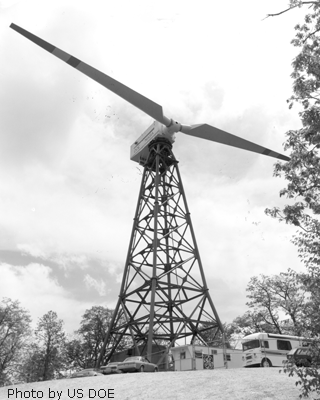 |
| Configuration: |
Downwind |
|
| Rotor Dia. [m] |
61 |
|
| Rotor r.p.m. |
- |
|
| Power [kW] |
2000kW |
|
| Power Regulation |
Pitch |
|
| Blade Number |
2 |
|
| Blade Material |
Steel |
Welded Steel |
Experimental system designed and built by General Electric Company. The Welded steel Blades were fabricated by the Boeing Aerospace Company.
Turbine was installed at Howard's Knob , near Boone, North Carolina. After 2 years of Test operation the Turbine was dismantled, when improperly-torqued bolts in Hub/Shaft interface failed.
This was the first Megawatt machine since the Smith-Putnam HAWT in the 1940s.
|
|
NASA/DOE MOD-2 |
|
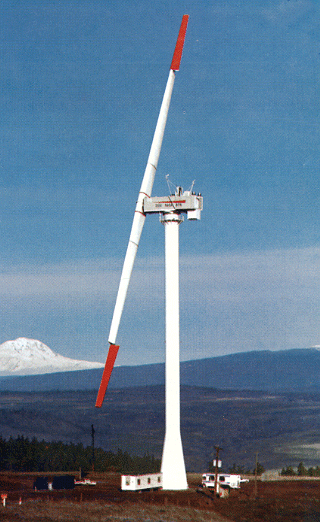 |
| Configuration: |
Upwind |
|
| Rotor Dia. [m] |
91.4 |
|
| Rotor r.p.m. |
- |
|
| Power [kW] |
2500kW |
|
| Power Regulation |
Partial Pitch |
Partial span pitch control |
| Blade Number |
2 |
|
| Blade Material |
Steel |
Welded Steel |
The Welded steel Blades were fabricated by the Boeing Aerospace Company.
3 MOD-2 Turbines were installed at Goodnoe Hills, near Goldendale, Washington.
Fatigue cracks at the Turbine Shafts were seen on the Turbines. Rotor fatigue Loads on this design was generally higher than predicted.
Two additional Mod-2 turbines were built by Boeing. One for PG&E at Solano County northeast of San Francisco and one at Medicine Bow, Wyoming.
All MOD-2 turbines were later dismantled. |
|
NASA/DOI WTS-4 |
|
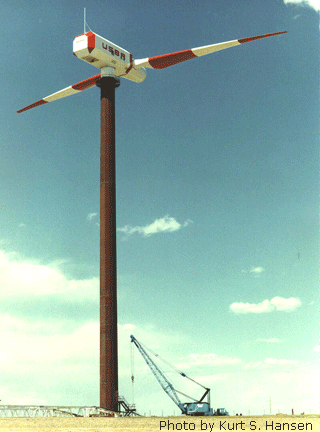 |
| Configuration: |
Downwind |
|
| Rotor Dia. [m] |
78.2 |
|
| Rotor r.p.m. |
- |
|
| Power [kW] |
4000kW |
|
| Power Regulation |
Pitch |
|
| Blade Number |
2 |
|
| Blade Material |
Fibreglass |
Filament Wound |
2 Turbines were built at Medicine Bow, Wyoming.
Main contractors were: Hamilton Standard Division of United Technologies Corporation and Swedish KarlskronaVarvet, a Swedish Ship Yard.
Picture: Blades hit the Tower. Finally the Turbine went to the scrap yard.
Hamilton Standard fabricated the filament wound blades.
A sister turbine in 3 MW size was built at Maglarp in south western Sweden.
After some bad damages the Turbine was sold to Medicine Bow Energy Company. who then repaired it. It worked until January 1994, when it was badly damaged after the control system malfunctioned in high winds. |
|
NASA/DOE MOD-5B |
|
| |
| Configuration: |
Upwind |
|
| Rotor Dia. [m] |
121.9 |
|
| Rotor r.p.m. |
- |
|
| Power [kW] |
7300kW |
|
| Power Regulation |
Pitch |
|
| Blade Number |
2 |
|
| Blade Material |
- |
- |
General Electric Company was chosen for the design of MOD-5A, but the company withdrew from the project at the conclusion of its design stage.
Thus the Turbine was newer built. |
|
|
1987 - |
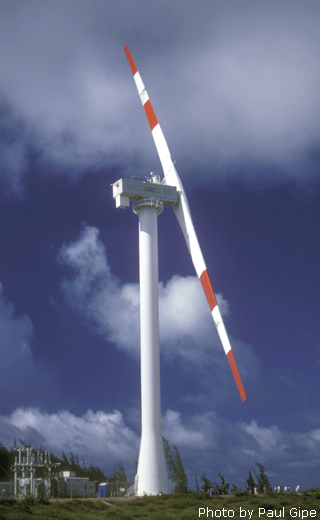 |
| Configuration: |
Upwind |
|
| Rotor Dia. [m] |
97.5 |
|
| Rotor r.p.m. |
13 - 17.3 |
Variable |
| Power [kW] |
3200kW |
|
| Power Regulation |
Partial Pitch |
Partial span pitch control |
| Blade Number |
2 |
|
| Blade Material |
Steel/ |
Main section welded Steel |
Boeing Aerospace Company built this Turbine, installed at Kahuku, Oahu, Hawai.
During March of 1991, the MOD-5B produced 1 256 MWh of electricity. Accordin to NASA this was the record energy production by a single Wind Turbine at that time.
(The cost of the produced electricity was not mentioned.)
|
|
Bendix / Schackle 3 MW |
|
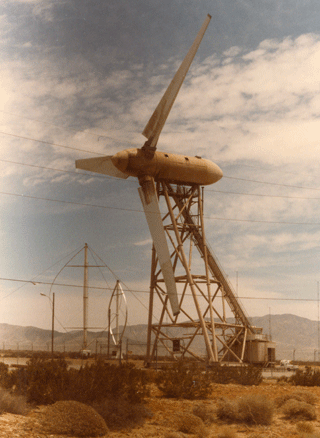 |
| Configuration: |
Upwind |
|
| Rotor Dia. [m] |
- |
|
| Rotor r.p.m. |
41 |
|
| Power [kW] |
3000kW |
|
| Power Regulation |
Pitch |
|
| Blade Number |
3 |
|
| Blade Material |
Wood/Fibreglass |
|
Southern California Edison installed this early giant at their Test Facility at San Gorgonio Pass, Palm Springs, California. Rotor manufactured of wood and fibreglass.
The drive train incorporated a special feature: A hydraulic transmission of the Rotor power on to the generator. Yaw system at the ground. The Turbine was erected around 1980 – Demolishion time unknown. In the picture background, the 500 kW Alcoa Darrieus Turbine, also tested by SCE.
|
|
 EOLE-VAWT EOLE-VAWT
|
1987 - |
|
|
| Configuration: |
Darrieus |
- |
| Rotor Dia. [m] |
96 |
- |
| Rotor r.p.m. |
- |
- |
| Power [kW] |
8800 |
- |
| Power Regulation |
- |
- |
| Blade Number |
2 |
- |
| Blade Material |
- |
- |
2-Bladed Darrieus machine.
|
|
|
|
copyright © 2006-2024 Nordisk AeroForm ApS
|
|

